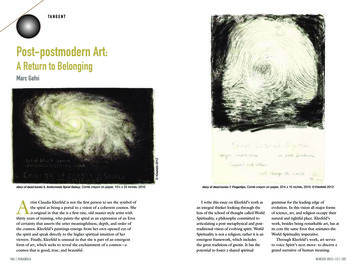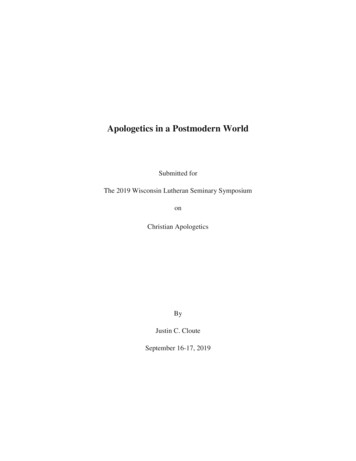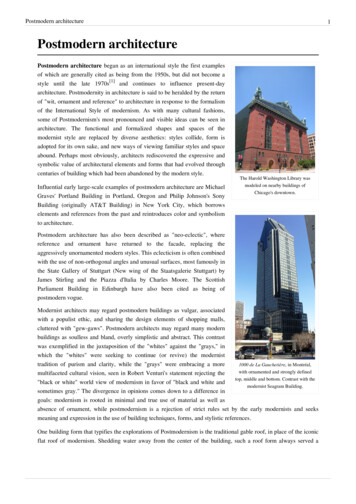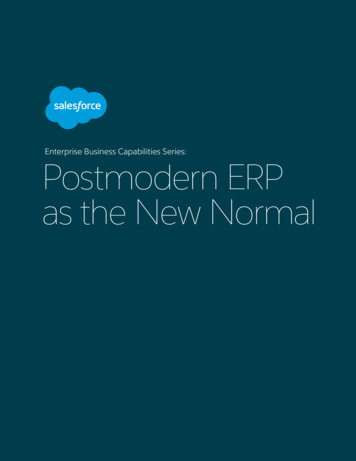
Transcription
TA N G E N TPost-postmodern Art:A Return to Belonging Kleefeld 2012Marc Gafnidiary of dead bones 5. Andromeda Spiral Galaxy, Conté crayon on paper, 15¼ x 23 inches, 2010Artist Claudia Kleefeld is not the first person to see the symbol ofthe spiral as being a portal to a vision of a coherent cosmos. Sheis original in that she is a first-rate, old-master-style artist withthirty years of training, who paints the spiral as an expression of an Erosof certainty that asserts the utter meaningfulness, depth, and order ofthe cosmos. Kleefeld’s paintings emerge from her own opened eye ofthe spirit and speak directly to the higher spiritual intuition of herviewers. Finally, Kleefeld is unusual in that she is part of an emergentform of art, which seeks to reveal the enchantment of a cosmos—acosmos that is good, true, and beautiful.106 PARABOLAdiary of dead bones 7. Fingertips, Conté crayon on paper, 22¾ x 15 inches, 2010. Kleefeld 2012I write this essay on Kleefeld’s work asan integral thinker looking through thelens of the school of thought called WorldSpirituality, a philosophy committed toarticulating a post-metaphysical and posttraditional vision of evolving spirit. WorldSpirituality is not a religion; rather it is anemergent framework, which includesthe great traditions of gnosis. It has thepotential to foster a shared spiritualgrammar for the leading edge ofevolution. In this vision all major formsof science, art, and religion occupy theirnatural and rightful place. Kleefeld’swork, besides being remarkable art, has atits core the same Eros that animates theWorld-Spirituality imperative.Through Kleefeld’s work, art servesto voice Spirit’s next move: to discern agrand narrative of human meaning.WINTER 2012–13 107
7KH UW RI %OLVVFinding Your Center, Getting in the Flow,and Creating the Life You Desire7HVV :KLWHKXUVW9780738731964 16.99“Joseph Campbell said to ‘followyour bliss,’ but who knows howto find it? Tess Whitehurst willshow you how.”—Penney Peirce, author ofFrequency and The Intuitive WayRoping Tornado, oil on linen, 10 x 16¼ inches,2011. Kleefeld 2012Kleefeld’s art, like World Spirituality,is about the Eros of wholeness andinterconnectivity. It is about beingable to—in a post-metaphysical, posttraditional, and post-dogmaticparlance—once again recognize “thepatterns that connect;” and throughthis recognition to experience, in firstperson, that sense of—to borrowKleefeld’s term—“ultimate belonging”in the universe.On WOrld Spirituality:To reiterate, World Spirituality is not areligion; it is a framework. Charles108 PARABOLATaylor reminded us in his classic workSOURCES OF THE SELF 1 that we all live in“inescapable frameworks.” RebeccaWest 2 has pointed to modern man’s“desperate search for a pattern.” Thegrand narrative of modernity andpostmodernity is that there is no grandnarrative. The emergence of a worldcentric, and even cosmocentric,consciousness has made many traditionalnarratives seem naïve and childish.Modernity’s scientism, with itsreductionist prejudice, has reducedmuch of the world to flatland. This iswhat critic Lewis Mumford meant whenhe talked about the “disqualifiations ofthe universe.” Depth is scarce either as avalue or a reality. Postmodernity, with itskeen insight that every expressed truthexists within a social, psychological, andhistorical context, challenges dogmas ofan absolute or eternal truth. We askourselves, inchoately, what can followall of the deconstruction?After the deconstruction of postmodernism we begin the greatreconstructive project of postpostmodernity. This is WorldSpirituality’s project: to weave thedurable insight of pre-modernity—thedepth and structure shared by all thegreat traditions—with the key insightsIn her lighthearted, easy-to-readstyle, Tess Whitehurst introducesyou to the nine life keys: serenity,life path, synchronicity, creativity,romance, radiance, prosperity,resilience, and synergy. Use theholistic blend of Eastern wisdomand alchemical essences totransform yourself, manifest yourtrue desires, and reconnect withyour natural state of kswww.tesswhitehurst.comwww.llewellyn.com 1-877-NEW-WRLDWINTER 2012–13 109
of modernity and postmodernity. Thisgreat reconstructive project bringstogether the empirical eye of the sensesand eye of the mind that created themodern hard and soft sciences, togetherwith the evolutionary hermeneutics setin place by postmodernity, and fromthem emerges the matrix of a new postpostmodern world view. What isrevealed in this reconstruction is a postmetaphysical and post-dogmatic visionof evolving patterns that connect. Itbecomes clear that all fields of knowingare part of a grand narrative, whichtranscends limited contexts and pointstowards a universal grammar ofmeaning. Once again the human beingis able to locate herself in the cosmos;once again humankind feels a senseof profound belonging and thus,responsibility for life in all of itsevolving forms.On the nature Of art, theartiSt, and the CritiC:In order to place my commentary withina larger context, let me share a widerview of art and particularly of artcriticism. From an integral perspective—a leading-edge mode of thinking thatseeks to incorporate into a largerwhole the partial truths of competingperspectives—there would seem to bethree core approaches to the issue ofhow to unpack meaning from art. Eachof these approaches to art and criticismis true but partial.The first approach suggests that whatis essential is the intent of the artist: Theartist injects the object with meaning.It is the job of the viewer to ascertainthe intent of the artist to the bestextent possible. Skewing this viewpoint,however, is the notion that the intent of110 PARABOLAA more integral view includes moretruth. This holistic strategy holds thatwe need to pay attention both to theintention of the artist, to the broadercontexts in which the artist works, andto the intrinsic evidence of the piece ofart itself.On levelS Of COnSCiOuSneSSand art:Book Spiral, books, floor to ceiling,approximately 8 feet, 2011–12. Kleefeld 2012the artist is not always conscious. Thecritic must unlock the unconsciousintentions that the artist may well haveimbibed from his or her cultural contextand imbued in the artwork. Accordingto this view, historical, cultural, and allother contexts are no less critical in“reading” art than the conscious intentof the artist.The second school believes that theinterior of the artist is irrelevant. Thiswas Heidegger’s view: Art must bejudged purely by the artwork itself,be it painting, sculpture, or novel.The third school usurps the place ofthe artist with that of the “critic.” Itclaims that the meaning of art restsneither in the intention of the artist’sconscious or unconscious, nor in thepiece of art itself, but in the reader’sinterpretation, or in the experience andinsight that the art evokes in the viewer.Another trinity of issues must beraised if one is to come to an integralappreciation of art. The first question iswhat level of consciousness is the artistworking from? Next, what faculties ofperception is the artist deploying increating the art? And third, what levelof consciousness does the art evoke inthe viewer?By “level of consciousness” I referto a distinct structure-stage of interiorconsciousness. Integral theorists pointout that these structure-stages havebeen broken down in roughly similarfashion by more than a hundreddevelopmental researchers workingindependently around the globe. Inthe moral line of development, levelsof consciousness might be seen asegocentric, ethnocentric, world-centric,or cosmocentric. This refers to thedepth of caring, concern, and empathyfelt by an individual. Is it limited to thatwhich is necessary for survival andsuccess (egocentric)? Does it extendfurther to the tribe or nation(ethnocentric), or perhaps even fartherto include all human beings on theplanet (world-centric)? Does the circleof caring and concern include allsentient beings in every generation,past, present and future (cosmocentric)?A second line of developmentalconsciousness refers to the cultural prismthrough which spiritual experience isinterpreted, including those outlined byJean Gebser3—magical, mythical,rational, pluralistic, and integral.If we read Spirit as mythic, forexample, which is the fundamentalistreading in religious dogma, themessage to be extrapolated from avisionary experience will be markedlydifferent than the same dream seenthrough the prism of the rational levelof consciousness, as it emerged fromWestern Enlightenment thinking.The identical dream will be read stilldifferently through a pluralistic levelof consciousness, as recognized in thelatter part of the twentieth century.These levels of consciousness are partof the context from which the artistcreates, the viewer views, and thecritic critiques.WINTER 2012–13 111
Akey question is what faculties ofperception does the artist deployin creating her art? Here thereare three core possibilities: They are theeye of the senses, the eye of the mind,and the eye of the spirit. The eye of thesenses looks at physical reality andreproduces it in art with as much inspiredskill as possible. The eye of the mindaccesses the interior world of symbolsand meaning; the artist creates from thatinner image. The eye of the spiritdiscerns directly—not through dogma—the interior realities of spirit throughcontemplation, intuition, or practice, andcreates art from that place of realization.This last understanding of art asderiving from the eye of the spirit iscentral in the teachings of early Hebrewmystics who point out that, in theoriginal Hebrew language, the words forfaith or trust in the divine and the word“artist” have the same etymology.Naturally, the eye of the spirit is refractedthrough the level of consciousness ofthe artist. An ethnocentric artist will seesomething differently through the eye ofthe spirit than will a world-centric artist!Finally, art may open up a deepervision in the viewer. The question iswhich eye of the viewer is opened: theeye of the senses, the mind, or the spirit?There is no one kind of art but multipleforms, all emerging from different levelsof consciousness, shaped by largercontexts, and reflecting the many visionsmade visible through diverse perceptions.On the pOSt-pOStmOdern artOf Claudia Kleefeld:With the integral meta-picture of art inmind, allow me to draw a line frommedieval to Renaissance art, throughmodern and postmodern art to what I112 PARABOLAam labeling post-postmodern art as it isexemplified in Kleefeld’s work.Medieval art in European history wasoften inspired or commissioned by theChurch. Its primary focus was to use theeye of the senses to depict compellingscenes from the scriptures or other articlesof faith. These were not scenes originallycomposed by the artist’s inner eye butrather attributions to “gospel truth” astaught by the Church. Religious arttended to be concrete and generally didnot reach towards the abstract or mystical.Even, however, when the artist did accessthe eye of the spirit as the inspiration forhis art, what he saw was refracted througha particular ethnocentric and anti-scientificlevel of consciousness, namely, the prismof dogma. This is critical to understand.Spiritual states, including the perceptionof the eye of the spirit, never exist in andof themselves. That is the greatpostmodern insight, foreshadowed byLurianic Kabbalah, which Integral Theoryhas placed front and center. Every spiritualstate is refracted through its particularlevel of consciousness. So the grandeurof spiritual art—virtually all art of themedieval period—was almost alwaysreflected through a mythological,fundamentalist lens.Renaissance art expresses arevolutionary nature that was later toexplode into the Enlightenment.Renaissance art was greatly concernedwith the objective world. It sought toreproduce the most beautiful andaccurate vision possible. In a recentconversation with integral philosopherKen Wilber while preparing this article,he pointed out that as perspective,dimensionality, and a desire to depictthings as they are seen began to be thedominant motif in European art, thereemerged a parallel of third-personperspective in formaloperational logic thatbirthed the scientific andindustrial revolutions.Third-person perspectivewas born in full forceand became the sourcecode for a nascentrational, scientific andartistic worldview. Theeye of the senses was adominant faculty inRenaissance art.Medieval andRenaissance art shareda sense of order andhierarchy. For theChurch, order wasrefracted through adogmatic ethnocentricprism in which thehierarchy of the churchwas said to be identicalwith the hierarchy ofnatural order. By theRenaissance era, a sensethat the naturalhierarchy and orderof the cosmos wereindependent of the Church wasbeginning to be explored. In thisdimension the eye of the mind began toassert its independence from the Church.Mystical experience and scientificinvestigation tentatively asserted theirindependence from the filter oforganized religion. It remained clear,nonetheless, that the world was ordered,with a beginning, an end, and a greatchain of being that linked all of realityinto the sacred text of the one uni-verse.This sense of order was shattered inmodern and postmodern art. (For thepurposes of this essay it is appropriate tolump the two together.) Modern art“Chi Rho” page from the Hiberno-Celtic Book of Kells,illuminated manuscript, c. 800rejected the exterior world of orderedobjectivity and located its source ofinspiration not in religious dogma, noreven in the outer objective world, but inthe subjective mind of the artist. Duringthe postmodern period, the distinctionbetween highbrow and low-brow artwas eliminated. Apples and mountains,everyday objects, and grand vistas wereaccorded the same authority. The eye ofthe mind superseded the eye of thesenses as the dominant faculty in art.Modern art was characterized by adislocation of forms, bold distortions, andthe arbitrary manipulation of objects.WINTER 2012–13 113
Objective reality was undermined in art asit was in thought. There is no story linein much of modern and postmodernliterature and art. The modern artist turnsto the inner eye of the mind and drawsinspiration not from the image before herbut from the images in her mind. There isan intentional destruction of received andtraditional forms. All that remains is theeye of the mind, the radical innersubjectivity of the artist. Because nothingcan be known objectively the artist assertsher subjectivity—and with it gains thefreedom to collapse time, linearity, form,and anything else that hints at a coherentnarrative of reality. Man is very much astranger in the world painted by themodern and postmodern artist. W. B.Yeats sums up the modern andpostmodern situation in both itspoignancy and its desperation:Now that the ladders are gone,I must lie down where all ladders start,In the foul rag-and-bone shop of my heart.Enter Claudia Kleefeld with her postpostmodern art, an authentic expressionof its era. Kleefeld is very much inrebellion against modern art and itsdeconstructions. The spiral, as it appearsin all facets of existence, is her holy grailand through linking all of the spirals thatappear in every dimension of existence,114 PARABOLAshe seeks to rebuild Yeats’s lost ladder.What is crucial is that she does not do soin a regressive manner but rather throughpowerful, evolutionary movement.Kleefeld’s art is inspired by the unifiedorder of all things, seeking to remind usthat we are not strangers in the universe.She writes, “I am working onunderstanding the mechanics of theUniverse as seen through the Spiral inorder to help us experience our belongingand a sense of our interconnectivity of allparts with the whole.” What is critical isthat Kleefeld’s art and texts are entirelypost-traditional, post-dogmatic, postmetaphysical, and even post-scientific ina limited sense of the term. She hassubliminally incorporated the modernand postmodern critique of religion. Herconsciousness is clearly world-centric at aminimum, and possibly cosmocentric.The spiral in Kleefeld’s art becomesa symbol for the post-metaphysicalpossibility of discerning patterns thatconnect. The Eros, the essentialwholeness of reality, is alluded to in thespiral, which appears in and animates allspheres of reality and knowledge. Kleefeldcaptures this in an image of books fromdifferent disciplines that find right balancein the magic of the eternal form.Kleefeld seeks in the spiral to re-qualifythe universe. In the exhibition Patterns ofNature: The Spiral and Interconnectedness,she depicts many images of the spiral,which abound in nature, science,mathematics, and religion in forms toonumerous to list here. Continuing thiswork in her upcoming exhibition, Patternsof Nature and Man’s Machinery, Kleefeldcontextualizes this pattern using one ofthe most famous spiral forms: thepinecone, a central emblem in theentrance to the symbol-laden Vatican. Shepoints out that the spiral appears inSumerian culture pollinating the tree oflife; as the sun god; in ancient Egypt; inthe hands of the Hindu deities; and on thestaffs of Osiris and Bacchus as well as thecontemporary papal staff. The fingerprint,fossils from the pre-Cambrian era, thespider’s web, the logarithmic spiral with itsstunning mathematical sophistication(including the Fibonacci sequence), thecaduceus with its winding snakes, theupside-down water spiral that is thetornado’s shape, a bee’s back, the octopusand the bat, and of course the cosmositself—all are revealed to be spiral forms.We find the spiral in music and in math. Iffine sand is sprinkled on a metal plate anda violin bow drawn across its edge, a spiralcorrelated to high numbers is revealed.Add to that the spiral patterns of theplanets in their orbit, Kepler’s Goldenratio, the symbolic forms at Glastonburyand Chartres Cathedral, the Nazca Lines,and in contemporary developmentaltheories, the pattern evolves of aninterconnected cosmos incarnate in theEros of the spiral. These concepts, someof which were derived from the artist’sinvestigations into hermetic and otherancient practices, were the basis for theexhibition in question.Kleefeld’s tenets are not formallyscientific but spiritual and artistic. Aflash of insight, which came to her in adream state, initiated the artist intodiary of dead bones 1. Word Spiral written in reverse,Conté on paper, 22½ x 30 inches, 2010. Kleefeld 2012WINTER 2012–13 115
Kleefeld depicts the spiral as anexpression of an Eros of certainty thatasserts the utter meaningfulness, depth,and order of the cosmos. Kleefeld doesnot intend for us to regress to premodern paradigms; rather, she asks herviewers to evolve towards postpostmodern meaning, where science andreligion inform each other. Each deploysa different eye: science the eye of themind; and religion the eye of the spirit.Each eye is mediated or refracted throughthe particular level of consciousness of theviewer into larger contexts. It isimperative that the interconnected unityof all of reality and its underlyingprinciples is once again experienced as theessential nature of the cosmos. Kleefeld’sartistic thesis is that we can re-access ourcore sense of being at home in a cosmosthat is intelligent and patterned. All ofthis, for Kleefeld, finds expression in thenatural archetype of the spiral.contemplation of the spiral. The spiralmeans for Kleefeld a heightenedawareness of what I would call the Erosof wholeness. Kleefeld views her art assparking from her own enlightenedstates—from, I would say, the momentwhen her own eye of the spirit wasmost open and clear. Her explicitintention is to invite viewers into theradical experience of belonging.“Patterns of Nature: The Spiral and Interconnectedness” exhibited in Chicago in 2012 atWoman Made Gallery. This show travels to LAArtcore in Los Angeles in December of 2012.1 Charles Taylor, SOURCES OF THE SELF: The Making ofModern Identity, (New York: Harvard UniversityPress, 1989).2 Huston Smith, THE FORGOTTEN TRUTH, (SanFrancisco: Harper One, 1976).3 Jean Gebser, THE EVER-PRESENT ORIGIN: Foundationsand Manifestations of the Aperspectival World, (Athens,OH: Ohio University Press, 1986).STATEMENT OF OWNERSHIPStatement of Ownership, Management, and Circulation (Act of August 12, 1970: Section 3685. Title 39, UnitedStates Code). Title of Publication: Parabola. Publication no. 104–830. Date of filing: October 1, 2012. Frequency ofissue: quarterly. No. of issues published annually: 4. Annual subscription price: 29.95. Location of Office of Publication: 20 West 20th St., 2nd Fl., New York, N.Y. 10011. Location of Business Offices of the Publisher: 20 West 20thSt., 2nd Fl., New York, N.Y. 10011. Name and address of the Publisher: Jeff Zaleski, 20 West 20th St., 2nd Fl., NewYork, N.Y. 10011. Editor: Jeff Zaleski, 20 West 20th St., 2nd Fl., New York, N.Y. 10011. Owner: Society for theStudy of Myth and Tradition, Inc., 20 West 20th St., 2nd Fl., New York, N.Y. 10011. Known Bondholders,Mortgages, and other Security Holders: None. Extent and Nature of Circulation (first number gives average no. copieseach issue during preceding 12 months, second number gives actual no. copies of single issue published nearest to filing date): Total no. of copies printed (23,072/23,029); Estimated paid circulation through dealers, carriers, street vendors, and counter sales (6,599/7,188); paid or requested mail subscriptions (9,701/9,421); Total paid and/orrequested circulation (16,300/ 16,609); Free distribution by mail (195/196); Free distribution outside the mail(121/170); Total free distribution (316/366). Total distribution (16,616/ 16,975). Copies not distributed: officeuse, left-overs, unaccounted, spoiled after printing (923/701). Returns from news agents (5533/5,353). Total(23,072/23,029). Percent paid and/or requested circulation (98%/98%). I certify that the statements made by meabove are correct and complete. Jeff Zaleski, October 1, 2012.116 PARABOLA2easy waysto subscribe1.2.visit our websitespiritualityhealth.comcall us!866-485-2026taking time for yourselfis the momentous first stepon the lifelong journeyof wellnesssave 45%only 19.95off thenewsstand pricefor one year ofinspirationvisit spiritualitspiritualityhealth.comyhealth.com WINTER 2012–13 117
Post-postmodern Art - Center for Integral Wisdom . s s










